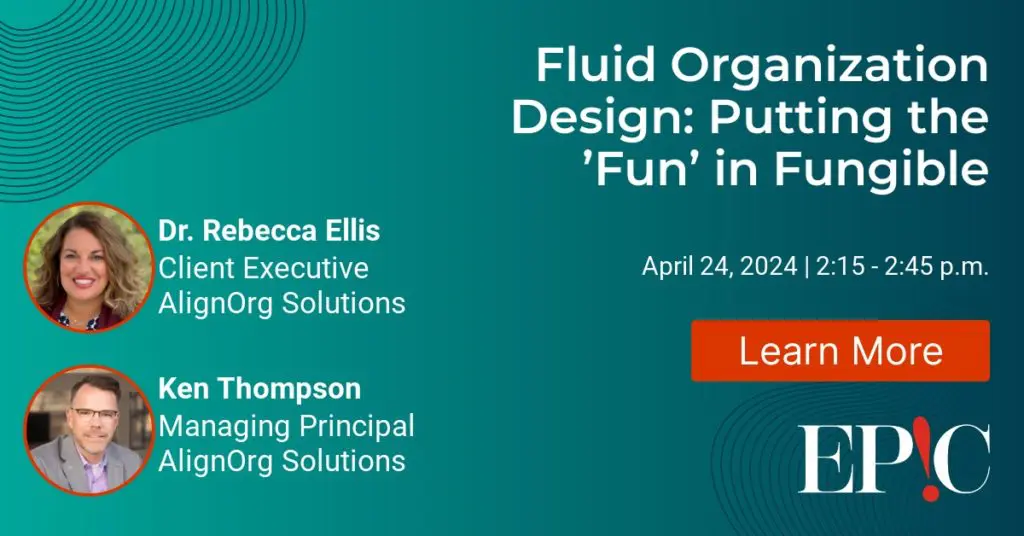What do Netflix and Whole Foods have in common? If you’re like me, they’re both key components of a great Friday night (a bowl of rocky road and binge-watching The Crown, anyone?) But beyond that, they’ve both taken unique approaches to managing talent that have allowed them to grow and succeed where many of their competitors have failed. Let’s discuss this flexible concept of hiring and staffing, often referred to as fungible talent. We’ll explore the many forms it can take and examine how we can intentionally design our organizations to support it.
What is Fungible Talent?
If you’re an employee at Netflix, your day might start something like this: you arrive at the office or log in remotely and begin working in a small, cross-functional team that was just assigned a new project. This modular team structure changes as priorities and resources shift. You have ownership of your work and you’re expected to make decisions autonomously. Netflix views their talent as fungible, which has helped them create an agile organization with the ability to pivot, address challenges and stay at the forefront of trends and new technology.
The term “fungible” typically refers to something that is interchangeable with something else of equal value – think trading the dollar in your pocket for 10 dimes. Applied to talent, it suggests that certain skills or capabilities possessed by individuals can be moved or transferred as needed. We most often think about fungible talent as being used in the tech industry. However, it can be successfully deployed by all kinds of organizations.
There are many variations on this philosophy. In fact, it’s likely that your organization has already dipped its toes into the fungible talent water in some form. Let’s examine just a few of the ways companies are using fungible talent.
How are Organizations Using Fungible Talent?
- Agile Workforce Models: Agile workforce models emphasize flexibility and responsiveness. They include utilizing a mix of full-time employees, contractors, freelancers, and gig workers to quickly scale as needed.
- Internal or External Talent Marketplaces: Talent marketplaces are platforms that connect organizations with independent contractors, freelancers, and other flexible workers. They enable companies to access specialized talent on-demand and quickly assemble project teams based on specific skill requirements. Internal talent marketplaces work on the same concept. Employees can explore short term projects or temporary assignments within the organization.
- Skill-Based Matching Platforms: Skill-based matching platforms use algorithms to match individuals with project opportunities based on their expertise and availability. These platforms enable organizations to quickly identify and engage the right talent for specific projects.
- Dynamic Team Structures: Rather than relying on traditional hierarchical structures, organizations are embracing dynamic team structures that can adapt to project requirements. This may involve forming cross-functional teams, project-based teams, or temporary task forces to address specific challenges or opportunities.

Is this a comprehensive list? No, in fact, in the wake of the pandemic, the number of alternatives to traditional teams and hierarchies has skyrocketed. In 2022, 85 percent of HR leaders said they were redesigning their organization to optimize some variation of fungible talent.
Putting the Fun in Fungible
Putting the “fun in fungible” is more than just a catchy phrase, especially if we think of “fun” in terms of helping employees find lasting job satisfaction, enhance their skills and become more valuable contributors in the marketplace. And that’s the beauty of fungible talent – when it’s done right, it creates an environment where employees can thrive while organizations increase creativity, improve retention rates and become more responsive to market changes. Here are two organizations that are reaping the benefits.
Spotify
The model: Spotify organizes its workforce into autonomous cross-functional teams called “squads.” Each squad is responsible for a specific area of the product and has all the skills necessary to deliver value. They have the freedom to make decisions independently and are accountable for the outcomes of their work.
The results: The squad model promotes flexibility and agility, allowing teams to adapt quickly to changing priorities and market demands. Within one year of adopting this agile structure, Spotify was able to increase product update frequency by 33 percent. Employee satisfaction increased by 20 percent.
Toyota
The model: Toyota has a longstanding job rotation program that allows employees to gain experience in different roles. Production line workers, for example, work in teams of 4–6 members, each assigned to a different task. Every member of the team knows how to do all tasks assigned to that team. Each task is graded red, yellow or green according to physical and mental difficulty. Teammates rotate throughout tasks, only taking “red” tasks for a portion of their shifts.
The results: These rotations minimize the physical and mental strain on workers and decrease downtime if one team member is sick, on vacation or leaves the company. It’s one of the company’s many strategies to increase efficiency alongside employee satisfaction – perhaps one of the reasons it received 100,000 applicants for 1,000 open positions when it opened its Plano, TX headquarters several years ago.
Designing Your Organization to Support Fungible Talent
Of course, not every organization is successful in their attempt to make talent more fluid. For every Netflix and Spotify, there’s a Sears, which despite investing in training programs to develop employees’ skills, failed to align them with evolving market trends. You can increase your chances of success by ensuring all areas of your organization are designed to support fungible talent.
We like to think of an organization as a six-sided Rubik’s Cube, with every “side” aligned to achieve a common goal. Here are some considerations to keep in mind as you examine how to move to a more dynamic and versatile way of staffing your organization.

Applying the AlignOrg Method
Work – Ensure that implementing a flexible approach to talent does not result in sacrificing the quality of work that differentiates you from the competition.
Structure – Determine how implementing new ways of managing talent will impact factors like information sharing, decision-making processes and reporting relationships.
Information & Metrics – When talent is fungible, the focus shifts from individual performance to team performance. Decide how to measure success based on the collective contributions of the team towards achieving their goals and objectives.
People and Rewards – As you move away from specific job roles, compensation must shift as well. You’re paying for skills and capabilities, not tenure and titles. At Whole Foods, for example, employees with certifications in specialized areas like organic farming or animal welfare may receive premium pay to reflect the value of market demand for this expertise.
Leadership and Culture – Ask yourself what organization choices and behaviors must be developed to support fungible talent. Netflix, for example, has crafted a successful but controversial results-based culture that allows them to maximize efficiency.
Continuous Improvement – Determine what mechanisms your organization will put in place to review changes to hiring and staffing and decide where improvements are needed.
Ready to Learn More?
Join me at EPIC 2024 April 24-26 in Las Vegas! I’ll be discussing ways to redesign your organization to support a fluid approach to talent. We’ll take a deeper dive into trends related to fungible resourcing, examine a matrix that can inform your design decisions and explore best practices and lessons learned.

